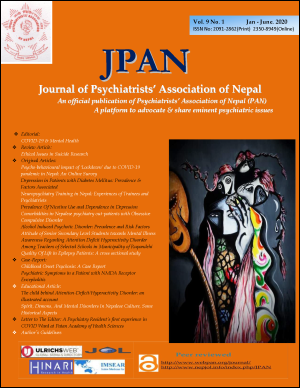Prevalence Of Nicotine Use and Dependence in Depression
DOI:
https://doi.org/10.3126/jpan.v9i1.31315Keywords:
Depression, Nicotine, Nicotine dependence, TobaccoAbstract
Introduction: Prevalence of tobacco use is universal and individuals suffering from mental disorders come with no exceptions. There is paucity of study looking into prevalence of tobacco use and nicotine dependence in patients with depression in low income countries like Nepal. Thus this study aimed at determining the prevalence of tobacco consumption, nicotine dependence and motivation to quit in patients with major depressive disorders.
Material And Method: A descriptive cross-sectional study was done among inpatient and out patients with diagnosis of depression at department of psychiatry and mental health, Tribhuvan University Teaching Hospital (TUTH). Data were collected using semi-structured Porforma and WHO STEPS Instrument for Nicotine Use. Fagerström Test for Nicotine Dependence, Modified Fagerström - Smokeless Tobacco, and Assessment of Motivation: Readiness to Quit Ladder was applied for nicotine users. Data were tabulated and analyzed using Statistical Package for Social Sciences version 20.0 (SPSS version 20.0).
Results: A total of 121 patients with diagnosis of depression were enrolled in the study. 37.2% (n=45) of patient used smoked tobacco only, 9.1% (n=13) used smokeless tobacco and 10.7% (n=11) used both smoked and smokeless tobacco. 92.3% of patients using smokeless forms of tobacco were nicotine dependent whereas this figure reaches to 81.8% in combined users. Median value of readiness to quit tobacco was 6 which indicates they often think about quitting but without any plans which was statistically significant (p<0.05).
Conclusion: Prevalence of nicotine use and dependence was found high among people with depression. Use of standardized and translated screening tools can be used efficiently to evaluate the burden of nicotine use in standard clinical practice in low resource setting like Nepal.
Downloads
Downloads
Published
How to Cite
Issue
Section
License
This license enables reusers to distribute, remix, adapt, and build upon the material in any medium or format, so long as attribution is given to the creator. The license allows for commercial use.




